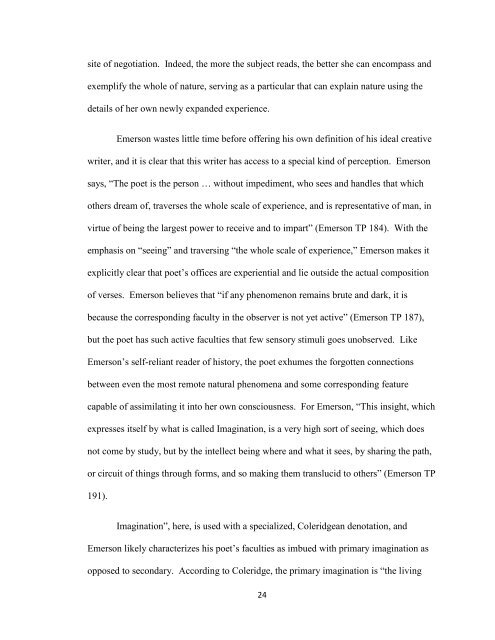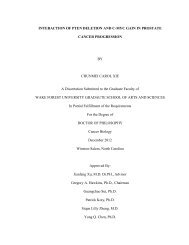RALPH WALDO EMERSON AND THE EVER-EVOLVING ART OF ...
RALPH WALDO EMERSON AND THE EVER-EVOLVING ART OF ...
RALPH WALDO EMERSON AND THE EVER-EVOLVING ART OF ...
Create successful ePaper yourself
Turn your PDF publications into a flip-book with our unique Google optimized e-Paper software.
site of negotiation. Indeed, the more the subject reads, the better she can encompass and<br />
exemplify the whole of nature, serving as a particular that can explain nature using the<br />
details of her own newly expanded experience.<br />
Emerson wastes little time before offering his own definition of his ideal creative<br />
writer, and it is clear that this writer has access to a special kind of perception. Emerson<br />
says, “The poet is the person … without impediment, who sees and handles that which<br />
others dream of, traverses the whole scale of experience, and is representative of man, in<br />
virtue of being the largest power to receive and to impart” (Emerson TP 184). With the<br />
emphasis on “seeing” and traversing “the whole scale of experience,” Emerson makes it<br />
explicitly clear that poet’s offices are experiential and lie outside the actual composition<br />
of verses. Emerson believes that “if any phenomenon remains brute and dark, it is<br />
because the corresponding faculty in the observer is not yet active” (Emerson TP 187),<br />
but the poet has such active faculties that few sensory stimuli goes unobserved. Like<br />
Emerson’s self-reliant reader of history, the poet exhumes the forgotten connections<br />
between even the most remote natural phenomena and some corresponding feature<br />
capable of assimilating it into her own consciousness. For Emerson, “This insight, which<br />
expresses itself by what is called Imagination, is a very high sort of seeing, which does<br />
not come by study, but by the intellect being where and what it sees, by sharing the path,<br />
or circuit of things through forms, and so making them translucid to others” (Emerson TP<br />
191).<br />
Imagination”, here, is used with a specialized, Coleridgean denotation, and<br />
Emerson likely characterizes his poet’s faculties as imbued with primary imagination as<br />
opposed to secondary. According to Coleridge, the primary imagination is “the living<br />
24




